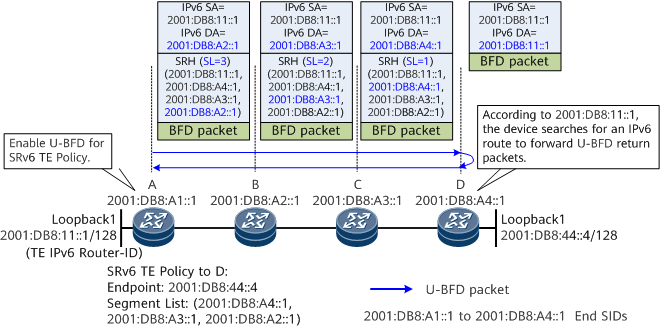U-BFD for SRv6 TE Policy
SBFD for SRv6 TE Policy requires you to configure the mapping between the reflector's IPv6 address and discriminator on the headend of the involved SRv6 TE Policy and configure the same reflector discriminator on the endpoint of the policy. If these requirements are not met, SBFD loopback packets cannot be constructed. In addition, you must ensure that the configured reflector discriminator is globally unique to avoid possible SBFD errors.
In inter-AS SRv6 TE Policy scenarios, the preceding constraints on the reflector discriminator make network planning inconvenient. To address this issue, unaffiliated BFD (U-BFD) for SRv6 TE Policy is introduced.
Fundamentals of U-BFD for SRv6 TE Policy
Figure 1 shows the U-BFD for SRv6 TE Policy detection process.
The U-BFD for SRv6 TE Policy detection process is as follows:
- After U-BFD is configured on the headend of the specified SRv6 TE Policy, the headend constructs a special BFD packet in which both the source and destination IP addresses in the IP header are the local IP address (that is, the TE IPv6 Router-ID) and both the local and remote discriminators are the same.
- The headend encapsulates a SID stack corresponding to the SRv6 TE Policy into the BFD packet. This transforms the packet into an SRv6 one.
- After receiving the SRv6 packet through the SRv6 TE Policy, the endpoint processes the packet, searches for a route according to the destination IPv6 address in the BFD packet, and then loops back the BFD packet to the headend.
If the headend receives a U-BFD reply, it considers that the corresponding segment list in the SRv6 TE Policy is normal. Otherwise, it considers that the segment list fails. If all the segment lists of a candidate path fail, U-BFD triggers a switchover to the backup candidate path.
U-BFD return packets are forwarded over IPv6 routes. In cases where the primary paths of multiple SRv6 TE Policies between two nodes differ due to different path constraints, if U-BFD return packets are transmitted over the same path and this path fails, all the involved U-BFD sessions may go down. As a result, all the SRv6 TE Policies between the two nodes go down. This problem also applies to U-BFD sessions of multiple segment lists in the same SRv6 TE Policy.
By default, if HSB is not enabled for an SRv6 TE Policy, U-BFD detects all the segment lists of only the candidate path with the highest preference in the SRv6 TE Policy. Conversely, when HSB is enabled, U-BFD can detect all the segment lists of the candidate paths with the highest and second highest preferences in the SRv6 TE Policy. If the segment lists of the candidate path with the highest preference all fail, a switchover to the HSB path is triggered.
Enabling U-BFD Traffic to Bypass Local Protection Paths
In a scenario where U-BFD for SRv6 TE Policy is deployed, if the segment lists of the primary candidate path fail, U-BFD remains up if a local protection path (such as a TI-LFA or TE FRR path) exists. For example, in TE FRR protection, if the current SID is unreachable, the SRv6 TE Policy uses the next-layer SID for forwarding. If this SID is still unreachable, the SRv6 TE Policy forwards the packet using the lower-layer SID until the destination IPv6 address of the packet changes to the TE IPv6 router ID of the headend. In this case, the BFD packets are looped back to the headend, and the BFD status remains up, which is inconsistent with the actual forwarding status of the SRv6 TE Policy.
To resolve this problem, you can enable U-BFD traffic to bypass local protection paths. In this way, U-BFD goes down if the segment lists of the primary candidate path all fail, triggering the candidate path to also go down. As a result, traffic is switched to a backup candidate path or another SRv6 TE Policy.
Application of U-BFD in a Network Slicing Scenario
In an SRv6 TE Policy network slicing scenario, U-BFD can detect an SRv6 TE Policy based on a network slice. The detection process is as follows:
- After U-BFD for SRv6 TE Policy is enabled on the headend, U-BFD packets are forwarded based on the network slice.
- After receiving a U-BFD packet, the endpoint device sends a U-BFD loopback packet.
- If the headend receives the U-BFD loopback packet, it considers the SRv6 TE Policy normal. Otherwise, it considers the SRv6 TE Policy faulty and sets U-BFD to down.
In this scenario, you must ensure that network slicing is deployed for the SRv6 TE Policy in E2E mode and that the primary path is working properly. Otherwise, U-BFD fails.
